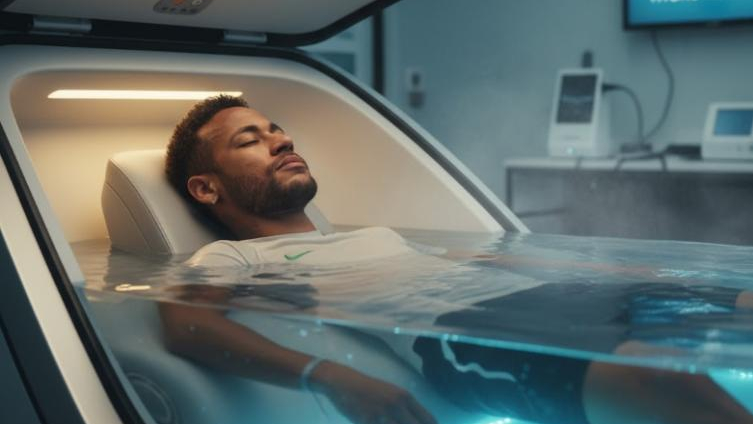How is science helping the health of athletes like Neymar, Messi, or Cristiano Ronaldo?

Sports medicine is undergoing a silent revolution that is helping major football and sports stars such as Lionel Messi, Cristiano Ronaldo, Neymar Jr., Kylian Mbappé, Ronaldo Nazário, Ronaldinho Gaúcho, among others. Monitoring technologies, advanced recovery methods, and new developments in physiotherapy are reducing injuries, speeding up comebacks, and allowing elite athletes to maintain peak performance for longer. This article clearly explains how tools like GPS, thermography, recovery baths, and other modern interventions help football players train safely and recover faster.
Monitoring that prevents surprises: GPS and wearables
Today, professional teams use satellite positioning devices and accelerometers to track every step, sprint, and jump players make during training and matches. These devices — commonly known as sports GPS — measure distance covered, top speed, number of sprints, accelerations, and decelerations, as well as calculate composite metrics representing the athlete’s workload. With this data, coaches can detect when a player is building up excessive load and adjust training before fatigue turns into injury.
Thermography: detecting inflammation without breaking the skin
Thermography uses infrared cameras to map skin temperature. Areas with inflammation or micro-injuries usually show thermal patterns different from healthy tissue. Therefore, thermography works as a non-invasive tool to detect “hot spots” that may indicate a risk of muscular or joint injury. Medical teams use it alongside clinical evaluations to prioritize exams and interventions.
Recovery baths and floatation therapy
Active and passive recovery has become routine in modern football. Among the available options is floatation therapy in recovery baths. Floatation sessions promote muscle relaxation, reduced perceived pain, and better subjective recovery after intense training. Controlled studies show that floatation can lessen muscle soreness and improve perceived recovery, making it a valuable tool in elite athletes’ recovery routines.
Cold water, cryo-immersion, and thermal contrast therapy
Cold-water immersion and thermal contrast therapies remain widely used to reduce muscle soreness after intense effort. Scientific reviews indicate that cold-water immersion can decrease pain and accelerate perceived recovery, especially when applied immediately after exercise. These strategies are implemented with specific temperature and duration protocols to maximize benefits and minimize risks.
Compression techniques and circulation
Pneumatic compression sleeves and boots are designed to improve venous return and speed up the removal of metabolites. Although widely accepted among athletes, scientific evidence varies depending on the protocol used. In some cases, intermittent compression provides temporary relief from stiffness, but it remains a subject of research to define who truly benefits and under what conditions.
Blood flow restriction training and accelerated rehabilitation
Blood flow restriction training uses adjustable cuffs to partially restrict blood flow to a limb during low-load exercises. This method allows for strength and muscle mass gains similar to those achieved with heavy loads but with less joint stress. For injured players, it’s a valuable tool for maintaining conditioning and accelerating rehabilitation without overloading healing tissues. Recent reviews report benefits in strength, power, and endurance when properly applied.
Percussion, manual therapy, and device innovations
Percussion guns and vibratory therapy devices have gained popularity in both preparation and recovery. Studies show that percussive therapy helps reduce muscle tension, can relieve immediate pain, and supports acute recovery. When combined with manual therapy and mobilization techniques, this approach enhances myofascial release and range of motion — critical factors for athletes who need to maintain explosiveness and agility.
Integrated analysis: from data to training plan
Data alone solves nothing. The real advancement lies in integration: systems that combine GPS, heart rate, sleep, perceived exertion, and thermography signals to build individual profiles. Multidisciplinary teams composed of fitness coaches, doctors, physiotherapists, and performance analysts interpret these signals and fine-tune training volume and intensity. This reduces overload risk and improves player availability throughout the season.
Modern physiotherapy: technology in service of recovery
Sports physiotherapy has evolved tremendously. In addition to manual techniques, professionals now use virtual reality for motor reeducation, balance assessment platforms with sensors, AI-powered motion analysis, and biofeedback systems to correct running and jumping patterns. Functional imaging tools and inertial sensors help objectively track progress, accelerating safe return-to-play decisions.
Active prevention: risk testing and personalized interventions
Strength, flexibility, and movement analysis tests help identify asymmetries and risk patterns. Based on these results, customized programs for strength, motor control, and mobility are designed. Intelligent prevention reduces the incidence of muscle and joint injuries — which, in the long run, is just as important as any quick recovery method.
Everyday examples from a football star’s routine
A player of Neymar’s caliber follows a routine that combines all these tools. Before and after training, monitoring checklists with GPS and sensors are used. After intense matches, sessions may include thermography to detect heat points, recovery immersions, floatation for relaxation, and physiotherapy with percussion devices and blood flow restriction training during early rehabilitation phases. All this data is recorded and analyzed to adjust rest periods and prevent load peaks. The goal is simple: keep the player healthy and ready to perform at top intensity.
Limits and ethics in technology use
Even with all these advances, ethical and practical concerns remain. The use of personal data demands protection and transparency. Not every technology has robust evidence, and personalization is expensive. Moreover, pressure for results may lead to indiscriminate use of unproven therapies. Therefore, decisions should always go through medical committees and be based on scientific evidence and the athlete’s best interest.
Conclusion
Science and technology have made football safer and more predictable. Tools like GPS, thermography, floatation recovery baths, immersion therapies, compression, blood flow restriction training, and percussion form an arsenal that helps prevent injuries and speed up recovery. When properly integrated into a multidisciplinary plan, these interventions allow elite athletes to maintain performance and readiness to compete consistently. The future promises even greater personalization and data-driven interventions — always with responsibility and focus on athlete health.
Sources:
- Ravé G. et al. How to Use Global Positioning Systems Data in Soccer Performance Management. (Review on GPS use in football).
- Maior AS et al. Profile of Infrared Thermography in Elite Soccer Players. (Thermography applied to football).
- Caldwell LK. Floatation-REST and Recovery After Exercise. (Controlled study on floatation and recovery perception).
- Xiao F. et al. Effects of Cold Water Immersion After Exercise on Fatigue and Recovery. (Meta-analysis on cryo-immersion).
- Yang K. et al. Effects of Blood Flow Restriction Training on Sports Performance. (Review on BFRT).

